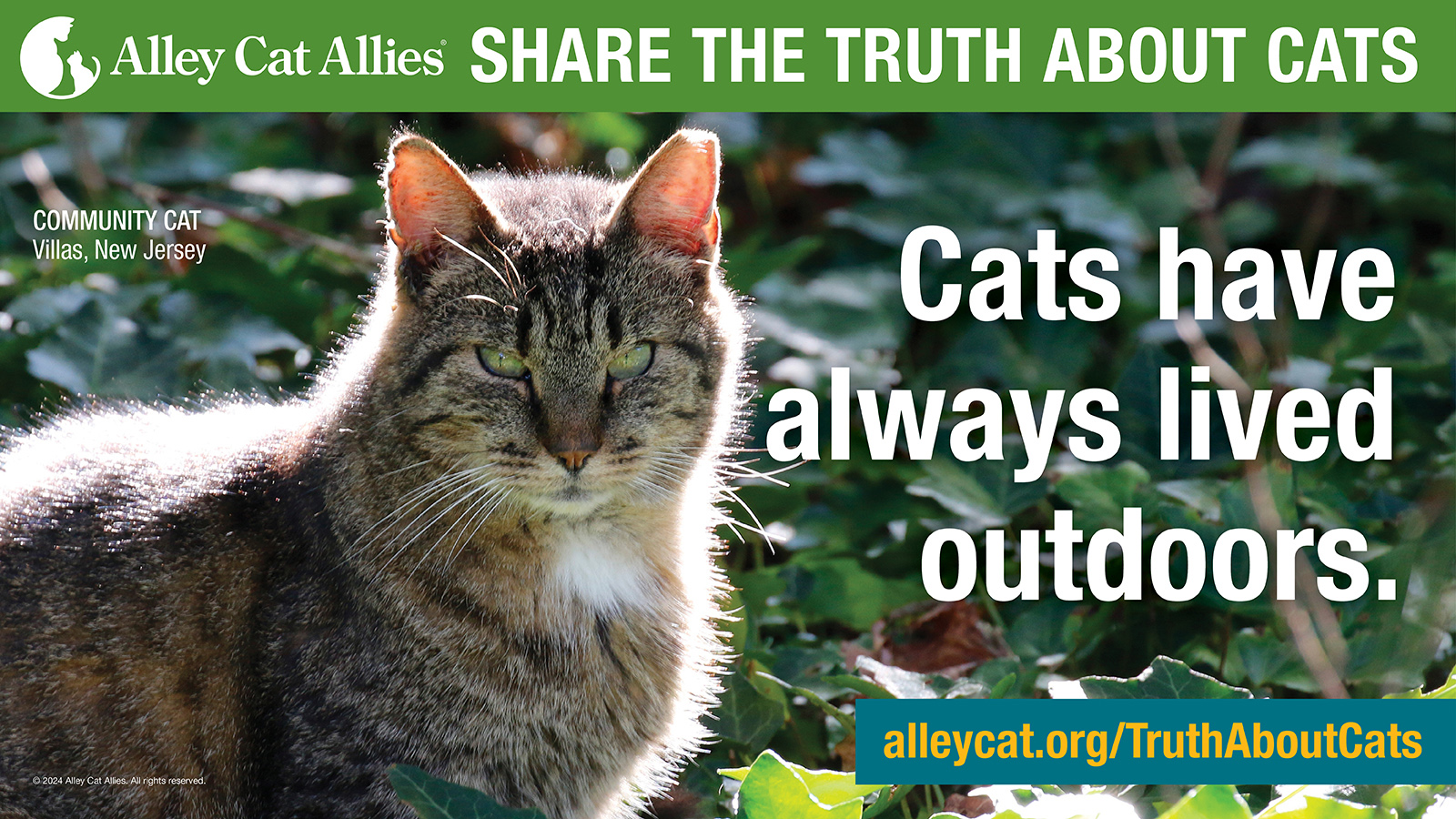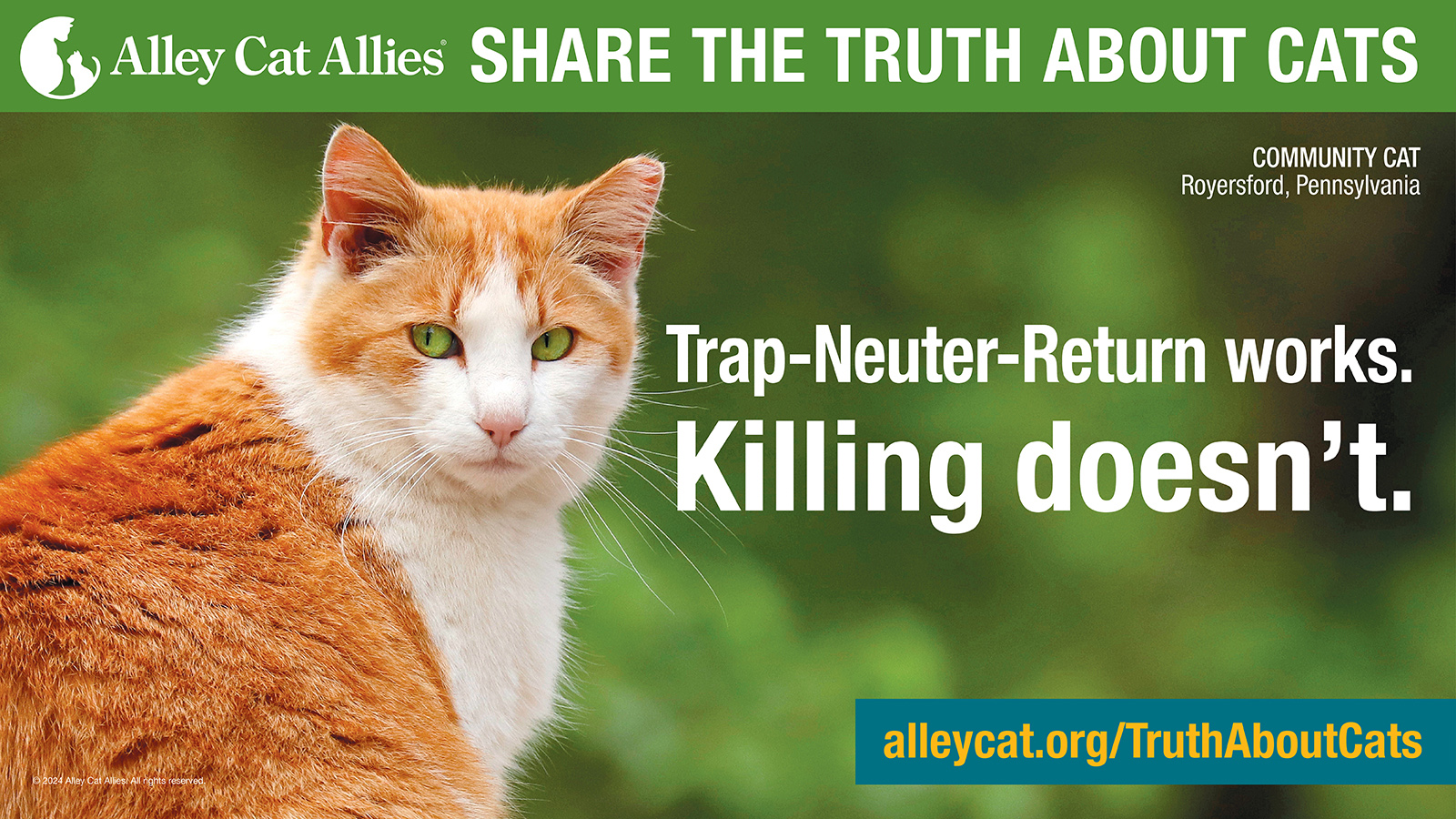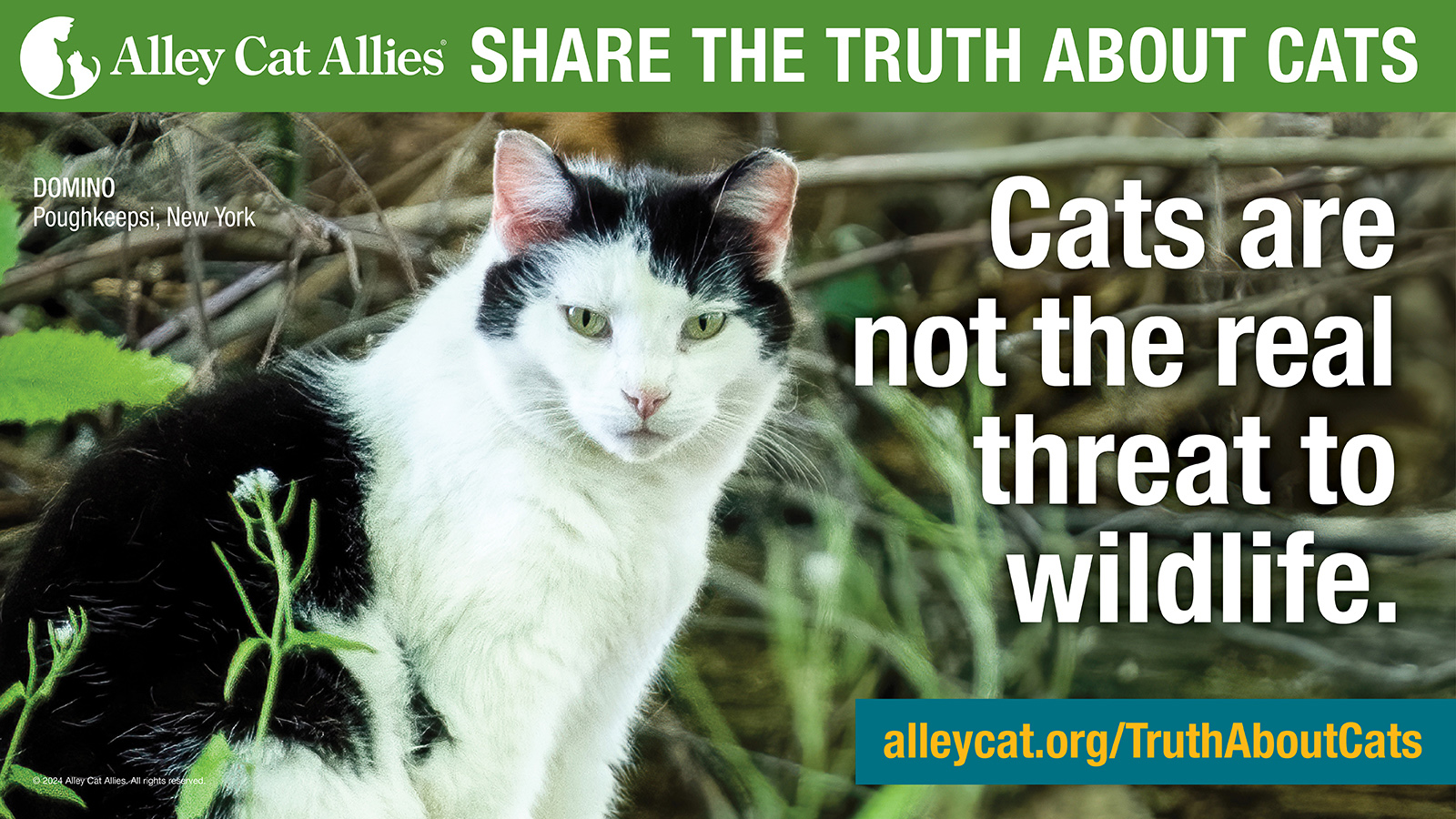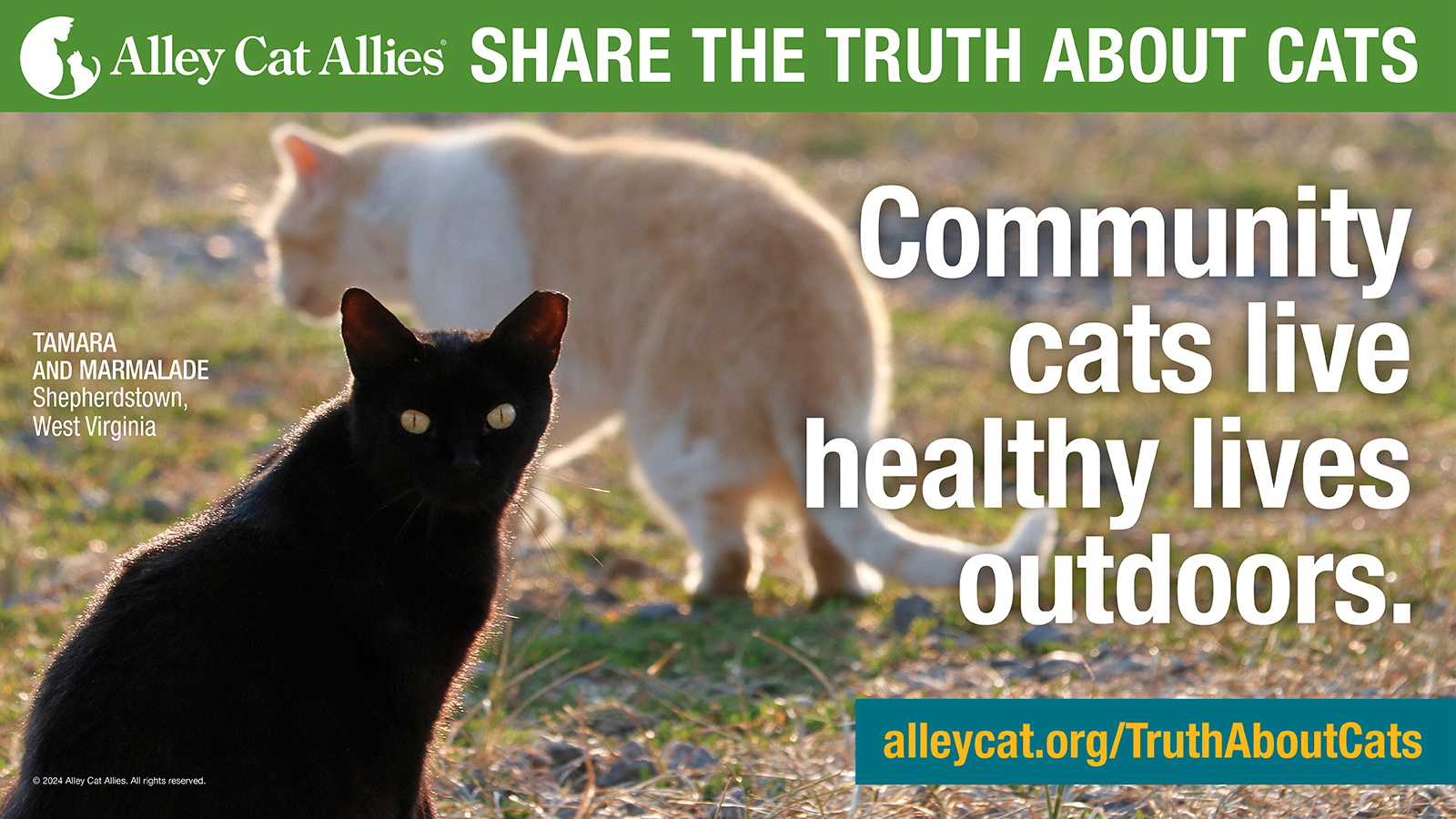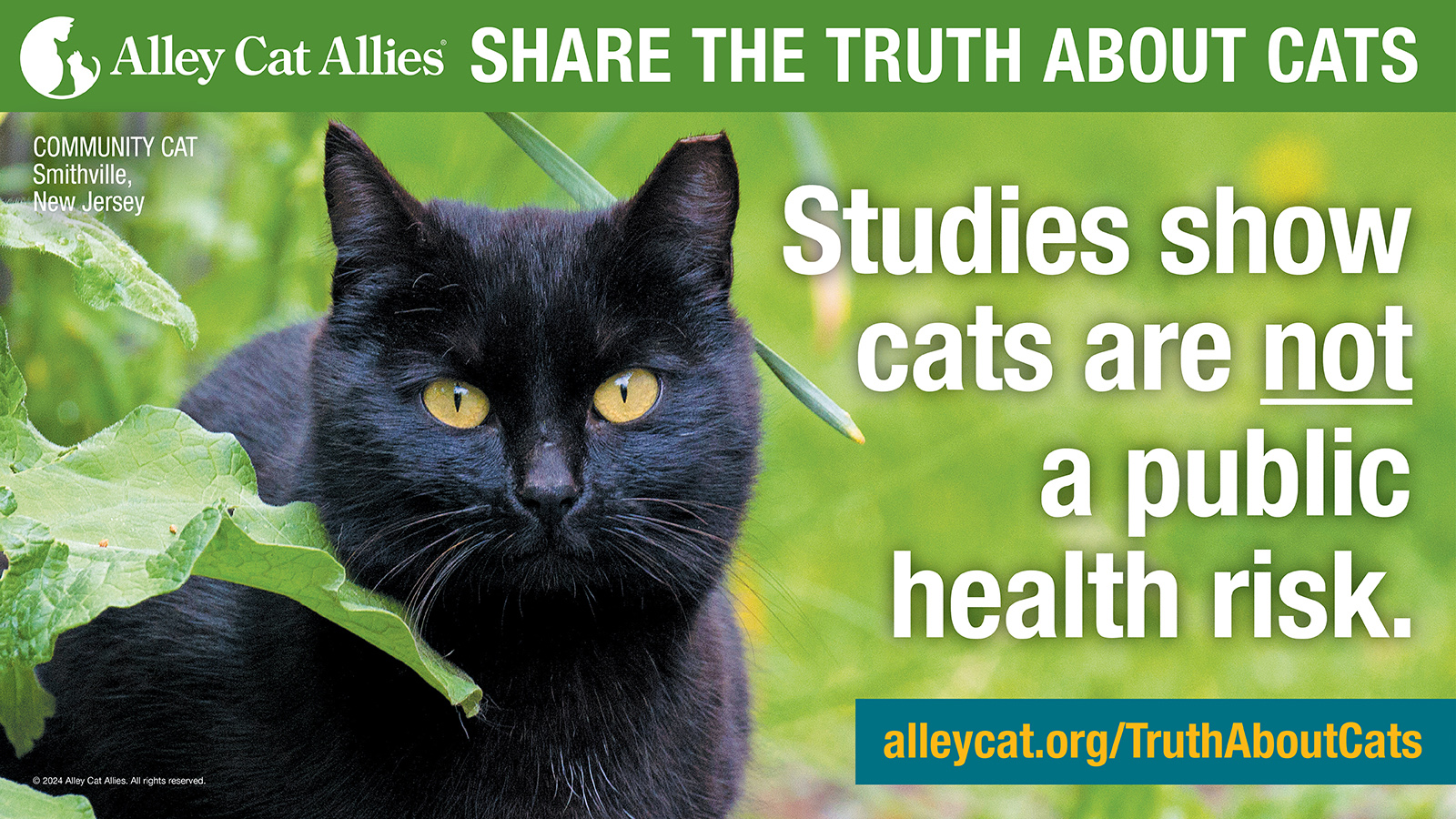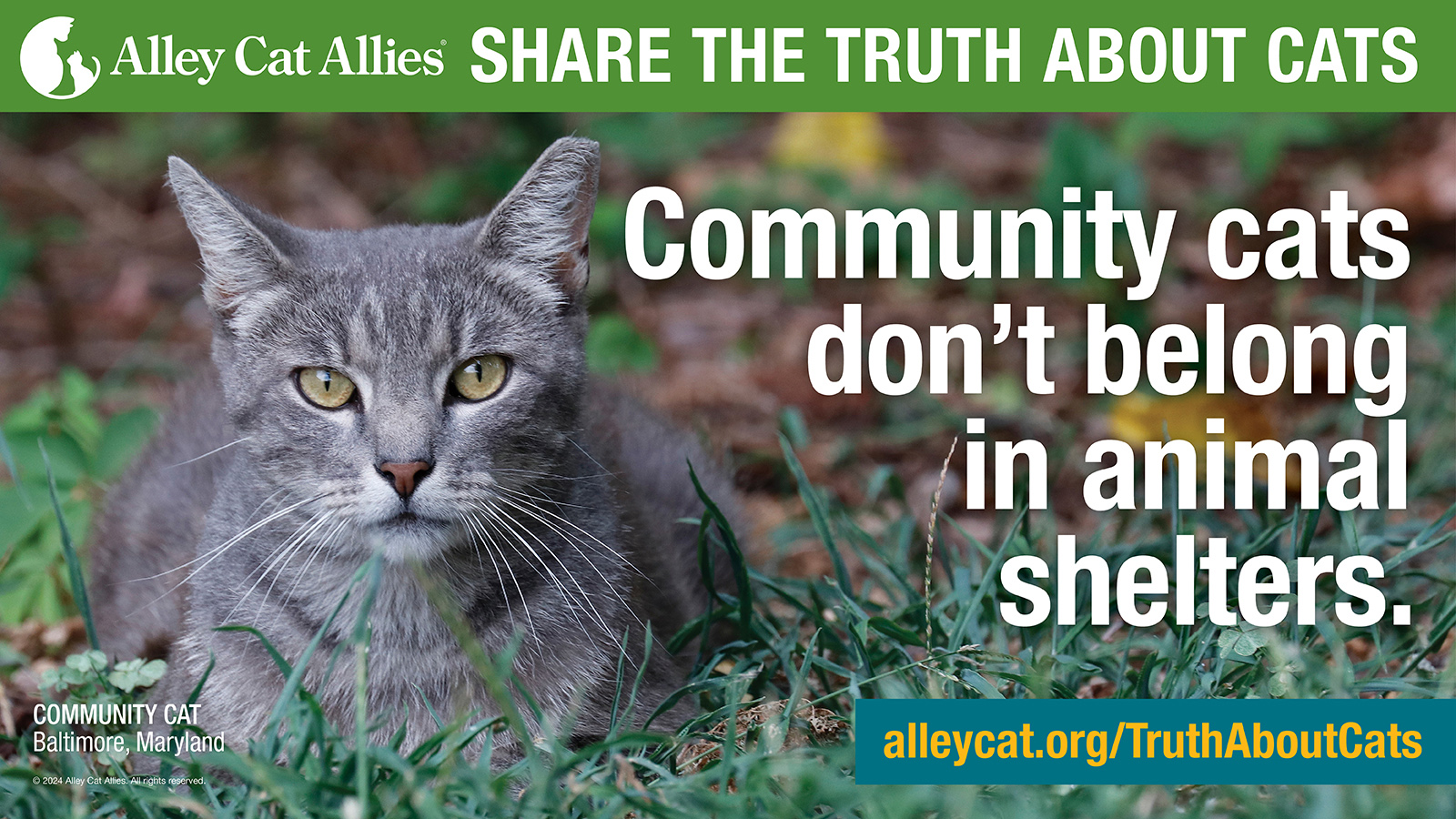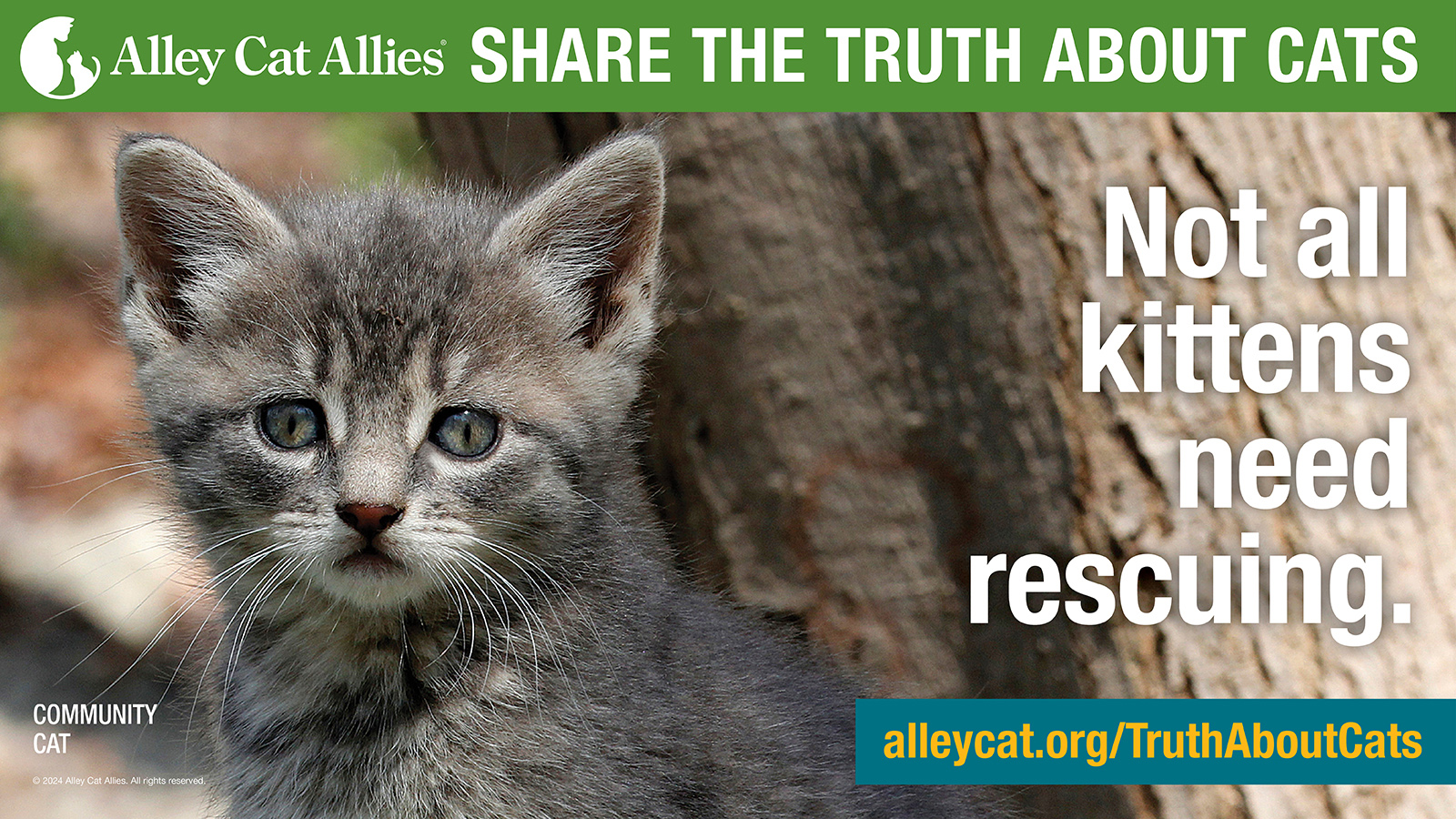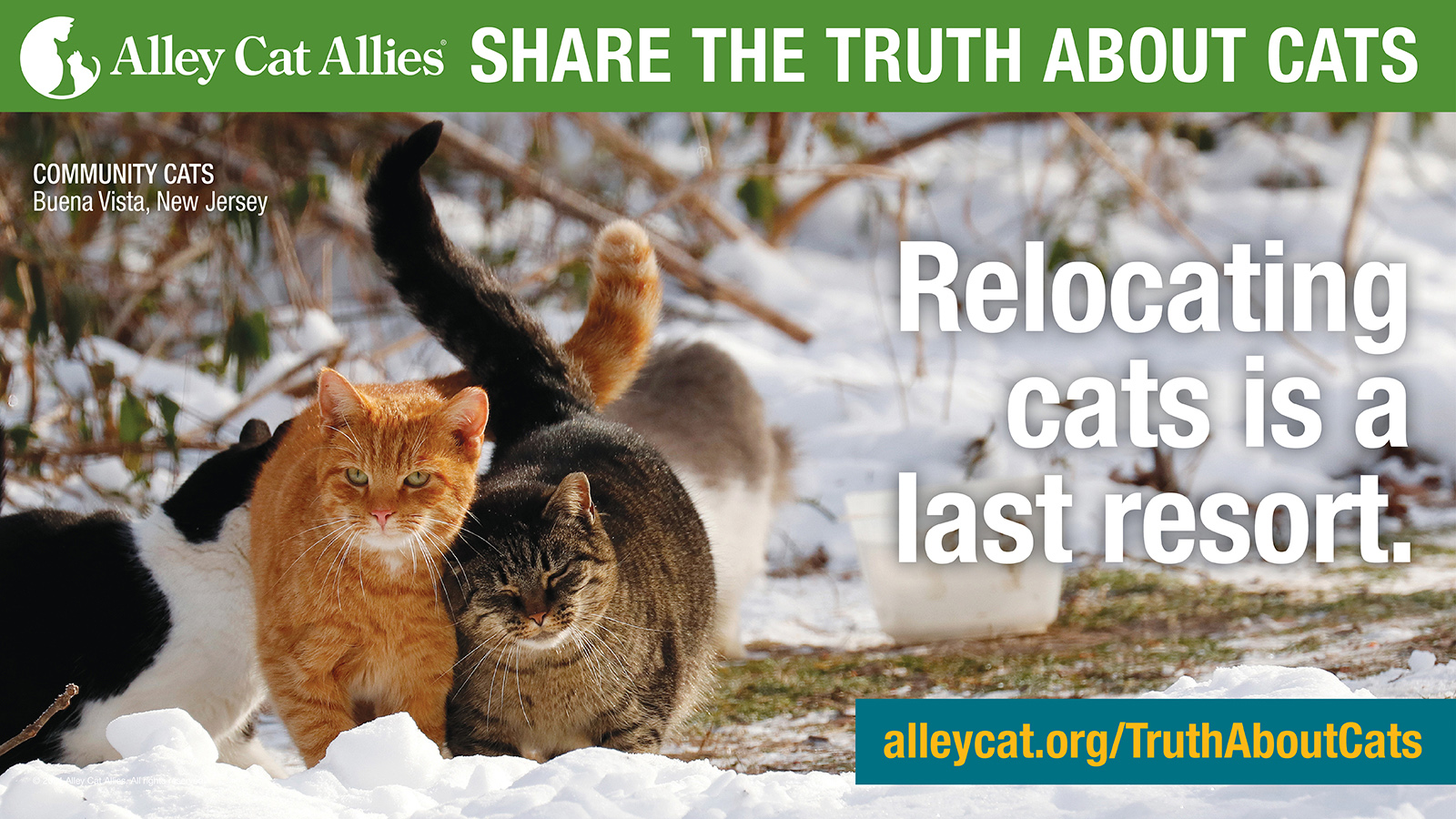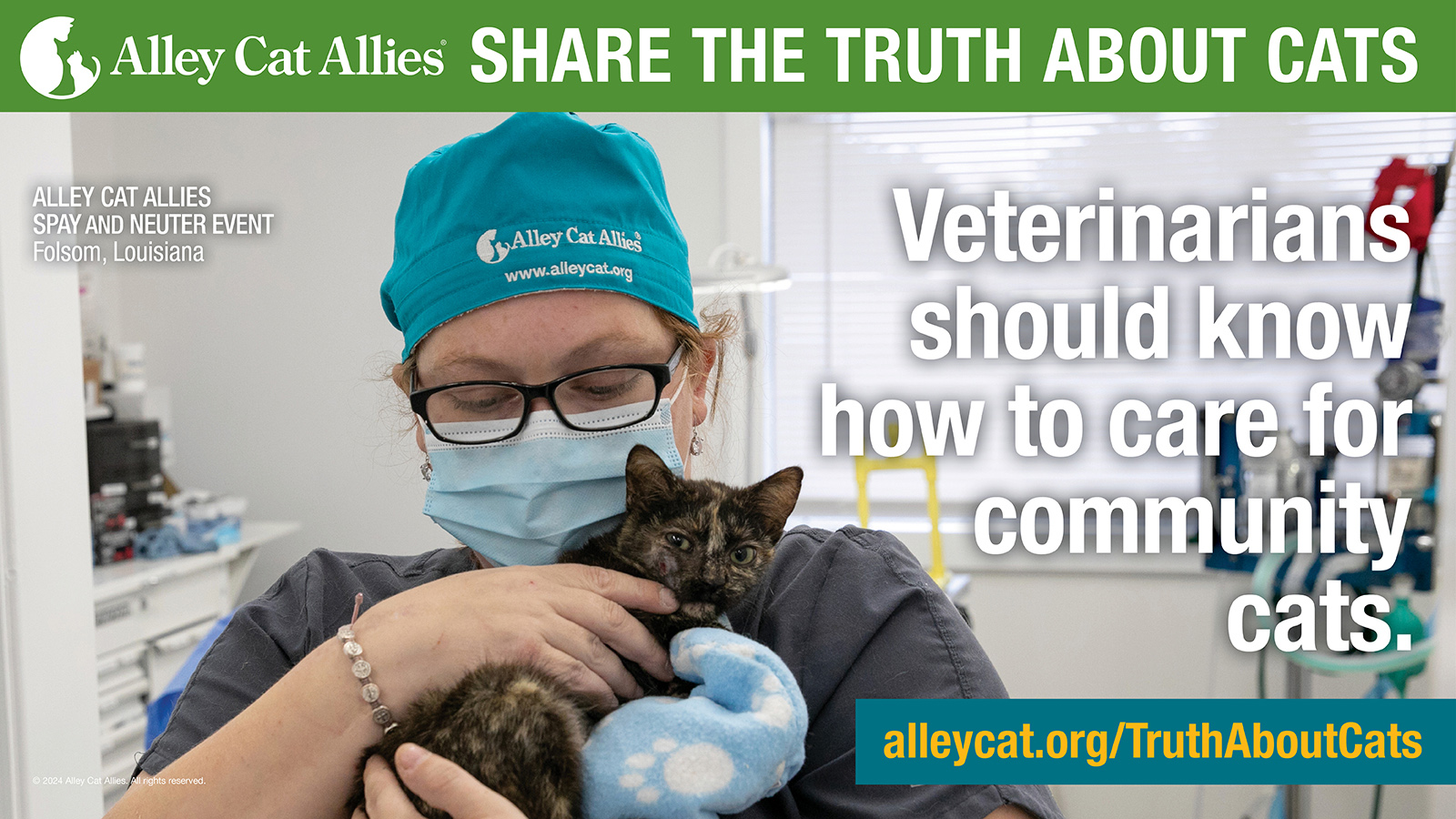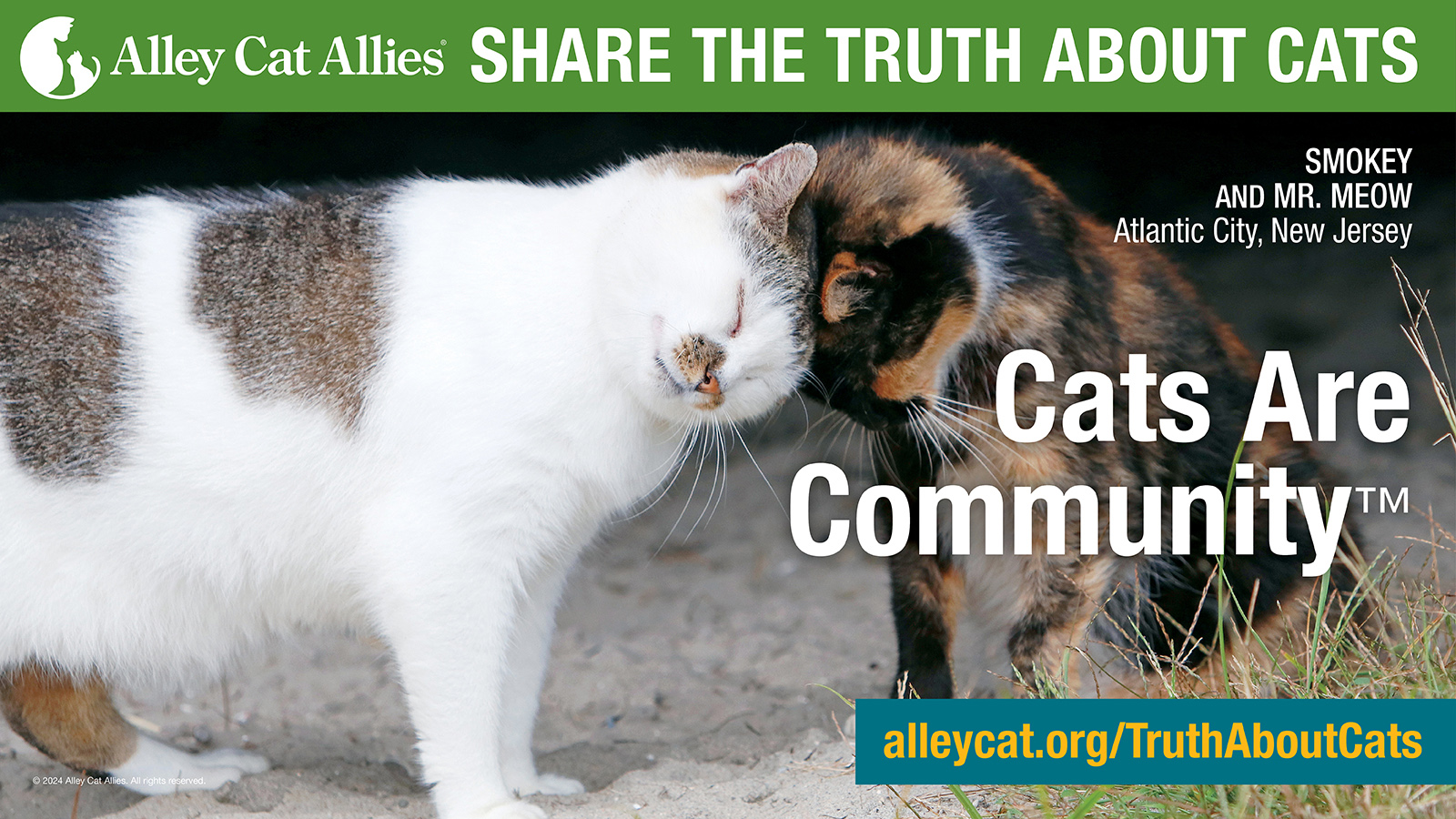to download Adobe PDF version.
Disinformation costs millions of cats their lives every year. Help us Share the Truth to stop the cruelty.
Though community cats and Trap-Neuter-Return (TNR) programs thrive in communities around the world, both face dangerously misinformed portrayals in the media and other avenues. It goes beyond just unpleasant words; this misinformation fuels the creation and continuation of cruel and lethal policies against cats and kittens in communities, parks, shelters, and more.
As the leader of the global movement to protect and improve all cats’ lives, Alley Cat Allies is committed to setting the record straight. But we need your voice to have the widest, most impactful reach. By educating people on the truth about community cats and combatting false claims, we can stop the killing.
FACT: Cats live outdoors—always have, always will.
The truth is cats have lived and thrived outdoors for thousands of years, and it is their natural environment and their home. In fact, cats lived nearly exclusively outdoors until the invention of kitty litter in the 1940s sparked a trend to have cats as indoor companions. Cats will always be outdoors, belong outdoors, and are bonded to their territories and feline families.
Policies that impound, and inevitably kill, cats who live outdoors under the misguided notion that they “belong” indoors are fundamentally flawed, cruel, ineffective, and not sustainable. Community cats, or unowned cats who live outdoors, are generally not candidates for adoption as they are not socialized to people. They cannot adapt to an indoor home…and that is not a problem to solve.
Community cats should be left to thrive in their outdoor homes and supported through Trap-Neuter-Return (TNR). TNR acknowledges community cats’ nature, biology, and inherent value as beings deserving of respect and protection by allowing them to continue their lives in familiar surroundings while ensuring their population stabilizes.
The truth is that it is natural for cats to live outdoors. Learn more about the natural history of the cat and how cats are biologically adapted to living outside.
FACT: Trap-Neuter-Return (TNR) is the only humane and effective approach to community cats.
TNR is the ONLY evidence-based, humane, and effective approach to cats outdoors. Through TNR, cats are humanely trapped, brought to a veterinarian to be spayed or neutered, vaccinated, and eartipped for identification, then returned to their outdoor homes. The “neuter” in TNR means fewer kittens born outdoors and the reduction of behaviors associated with mating—including yowling, spraying, fighting, and roaming. The success of community TNR programs is studied and documented.
Developing objective, science-first best practices that support peaceful communities and protect all species should be a top priority in our modern world. That is why TNR has become the standard for the humane care of community cats. Beyond respecting cats’ biology and natural place in the environment, TNR is sound public policy that reduces calls to animal control, reduces the number of cats entering shelters, and reduces taxpayer expense, all while meeting the demands of the public for effective, meaningful, AND lifesaving action for cats in their communities.
TNR opponents’ proposed “alternatives” to TNR come down to rounding up and killing cats over and over and over again. However, trapping cats and “euthanizing” them in shelters is not an untested idea; it was the status quo for decades and failed miserably due to the Vacuum Effect—a phenomenon in which other cats move in to take advantage of the resources that sustained the colony that was removed. Alley Cat Allies launched TNR into the mainstream against a backdrop of endless, futile, and cruel catch and kill cycles in the United States, and we were successful because communities recognized the need for change. They saw that compassionate and humane approaches worked while lethal cruelty did not.
The truth is that TNR works and killing doesn’t. Learn more about the lifesaving power of TNR.
FACT: Cats are not the real threat to wildlife—human-led development is.
The truth is cats have a place in ecosystems, and whenever they are removed or killed in large numbers, the consequences are dire—not just for the cats but also for wildlife. Several prominent ecologists acknowledge that cats play an important role in many ecosystems, often stepping in to fill the place of now-extinct or greatly diminished small predators.
Cats are not the major threat to wildlife species, endangered or otherwise, and much of the “science” that claims such is heavily flawed and funded by fringe interests and biased parties.
Those opposed to Trap-Neuter-Return (TNR) and the humane treatment of community cats continuously and relentlessly call for shooting, poisoning, and other methods of mass killing of cats and kittens. But as we have seen time and time again, lethal approaches to cats outdoors lead to nothing but an endless cycle of expensive and morally bankrupt slaughter that does not benefit cats, communities, or wildlife.
As for the main threats to wildlife, leading biologists and environmental watchdogs agree that human-led activities, including climate change, habitat destruction, and development, are far and away the number one cause of wildlife depletion.
We can protect both cats and wildlife. The interests are not mutually exclusive. By advocating for stronger TNR programs backed by local governments AND policies that curb human-led activities that are the true threats to wildlife—like habitat destruction and pollution—we improve the lives of cats, wildlife, and us all.
The truth is that cats are not the major threat to wildlife species—human development is. Learn more about the relationship between cats and wildlife.
FACT: Community cats can live long and healthy lives outdoors.
Despite TNR opponents claiming that community cats suffer terribly and live short and brutal lives outdoors, the facts say otherwise. Community cats are generally healthy and in good condition and can live as long and fulfilling of lives as indoor cats. They also have equally low rates of disease as indoor cats.
If the cats’ health is a concern, TNR is the primary way community cats receive rabies and FVRCP vaccinations and treatment for any other medical issues. Spaying and neutering also improve the cats’ well-being by removing the stresses of mating and pregnancy and preventing certain reproductive cancers.
Make no mistake, TNR opposition’s misinformed portrayal of cats outdoors as inherently suffering has only one motive: justifying endless and ineffective mass killing schemes against community cats.
The truth is that community cats are generally healthy and thrive in their outdoor homes. Learn more about how community cats live happily outdoors.
FACT: Cats are not a public health threat.
The truth is you are more likely to catch an infectious disease from a person in line with you at the grocery store than from a cat. Research supports what we all know: cats and people can live healthily side-by-side, as we have for thousands of years.
Additionally, vaccinations provided during TNR improve community cats’ health and address community health concerns—though it’s critical to note that cats are extremely unlikely to spread rabies, toxoplasmosis, or any other diseases.
Despite scaremongering about toxoplasmosis, for example, people have a far higher chance of contracting the infection from eating undercooked meat or unwashed fruits and vegetables than from a cat’s litter box.
And though rabies is often cited in bogus and disturbing claims that community cats are a threat to people and killing them is justified, the facts paint a different picture. Any glimpse into the history of rabies transmission in the U.S. will show that cats are far from a major rabies threat. Cats rarely contract rabies, let alone spread it.
The truth is that community cats are not a public health threat. Learn more about how cats are healthy members of our communities.
FACT: Community cats are too often killed in shelters.
Community cats are generally not socialized to people or adoptable. In shelters without lifesaving programs, these cats will be killed. In any shelter environment, community cats are highly stressed and very susceptible to disease. A community cat should only enter an animal shelter as part of TNR. In some TNR programs, cats are spayed or neutered at the shelter’s clinic!
Learn more:
alleycat.org/AnimalShelters
FACT: If kittens outdoors have their mother cat, Leave Them BeTM.
If you see kittens alone, their mother is likely close by, and her instincts make her their best caregiver. Kittens should never be separated from their mother to be brought indoors.
Watch for a few hours to see if the mother cat returns. If she does, you can help by providing her an outdoor shelter, food, and water.
Learn more:
alleycat.org/LeaveThemBe
FACT: Community Cats are bonded to their outdoor homes—relocation is dangerous.
Relocation of community cats is an absolute last resort and should only be considered if a cat is in imminent danger.
Community cats are highly bonded to their outdoor homes and the other cats in their colonies. Relocation rips cats from these homes and places them somewhere unfamiliar, which is extremely stressful and disorienting for them.
Learn more:
alleycat.org/Relocation
FACT: Every veterinarian should know how to respond to the needs of community cats and offer TNR services.
The veterinary community plays an essential role in the humane treatment of community cats by serving as a resource for the public and providing direct care, including spay and neuter.
All veterinarians should learn how to handle community cats, provide TNR services, never kill a cat based on FIV or FeLV diagnoses, and share knowledge and resources to help save community cats’ lives.
Learn more:
alleycat.org/Veterinarian
FACT: To protect community cats, a community must come together.
A community’s compassion can be measured in the treatment of animals—particularly community cats. Local officials should allocate funding to provide low and no-cost spay and neuter, other veterinary care, and food resources for cats.
Animal control officers and shelters should work together with veterinarians, advocates, and caregivers on the ground to provide TNR and other services for community cats. It takes everyone!
Learn more:
alleycat.org/CommunityRelations


